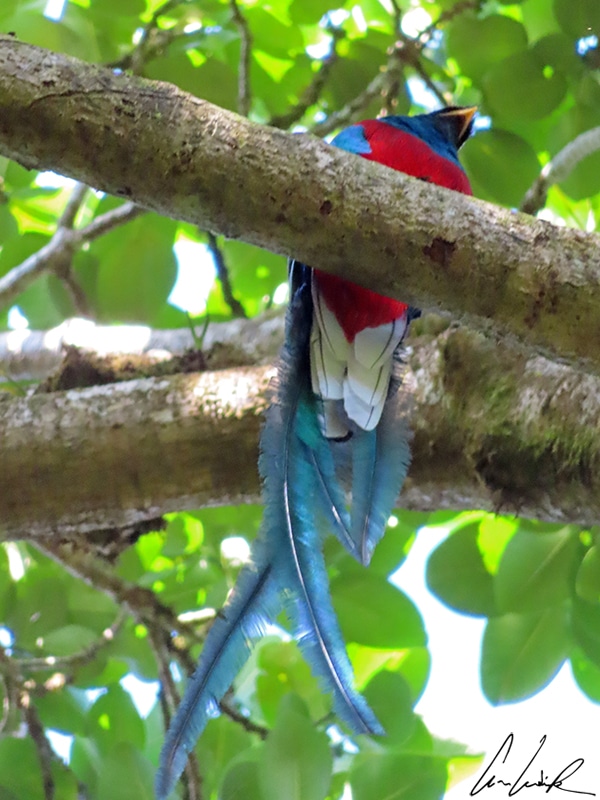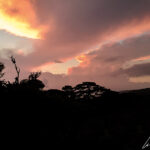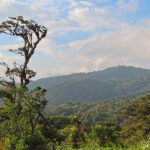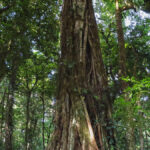- 1 A short stop at the Llanos del Cortés, a beautiful and refreshing waterfall
- 2 Monteverde: Santa Elena Reserve, an ecosystem rich in biodiversity
- 3 In search of the Resplendent Quetzal, the sacred bird of… Monteverde
- 4 The White Bellbird: the loudest bird in Monteverde… and in the world
- 5 The « Café Colibri » of Monteverde: the amazing ballet of hummingbirds
- 6 Find more on Costa Rica
Monteverde (Green Mountain) Located in the province of Puntarenas is one place not to be missed in Costa Rica. It is Costa Rica’s most important ecotourism destination. In 1951, American Quakers from Alabama purchased land in Costa Rica and moved there to avoid the Korean War draft, which went against their pacifism. They were overwhelmed by the beauty and biodiversity of the Monteverde Reserve. The Monteverde is about 4593 feet above sea level and covers 26,000 acres. Lush, dense green hills and mountains, evergreen vegetation, and biodiversity characterize the Monteverde cloud forest. The further we climb, the denser and greener the vegetation. It is a tropical mountain forest. Very humid and bathed in an almost permanent mist, it is also known as a cloud forest. You will have to be patient to get there because road 606 via Sardina is far from a pleasant ride. There is no paved road to reach Santa Elena (chief town of the district of Monteverde)… You will understand that going to Monteverde is not an easy thing and makes the Ticos laugh !

At 1500 meters above sea level, the trees and clouds of Monteverde are ghostly at sunset.
A short stop at the Llanos del Cortés, a beautiful and refreshing waterfall
The Cataratas Llanos de Cortés (Llanos de Cortés Waterfalls) is one of the most visited tourist attractions in the township of Bagaces in the province of Guanacaste. This waterfall is located just 2 miles north of Bagaces and about a 3-hour drive from San José. From Highway 1, the Pan-American Highway, you turn left after passing over the Rio Piedras to reach the entrance to the farm and parking. A short, easy path will take you first to a paradisiacal natural pool surrounded by rocks and abundant vegetation. The water is crystal clear with a pleasant temperature and suitable for swimming.

Near the waterfall of Llanos de Cortés, a natural pool is surrounded by rocks and vegetation.
However, resist the temptation to make a prolonged halt and continue towards the Llanos de Cortés waterfall under the indifferent eye of a Spectacled owl (Pulsatrix perspicillata) easily recognizable by its black « glasses » underlining its magnificent yellow eyes ! This bird of prey is not strictly nocturnal and rests alone in the tropical forest trees during the day. A few more steps and we arrive in a beautiful shaded area on a sandy beach: in front of us, an impressive view of the Llanos de Cortés waterfall !

The Llanos de Cortés waterfall is 12 meters high and 15 meters wide.
The Llanos de Cortés waterfall is 40 feet high and 50 feet wide. The water falls into a large and shallow natural pool and forms a transparent curtain in front of the rocks. It is very photogenic! You can cool off in this natural pool, swim to the waterfall and enjoy a moment of relaxation behind the water curtain or right under it !
« In the heart of a forest of greenery
On a well-worn rock
Droplets of water trickle down
Coming from a small stream
They slide on this grey rock
Slowly, without a hitch
Like a veil of tears
This waterfall charms us »
Monteverde: Santa Elena Reserve, an ecosystem rich in biodiversity
If you have ever wondered what a tropical forest, or cloud forest, nestled 5000 feet above sea level might look like, you’ve come to the right place. Above the Monteverde area, the dense vegetation and atmospheric conditions form a true cloud forest. The thick fog gives a magical touch to the various national reserves that can be visited. The Monteverde region’s biodiversity consists of over 2,500 plant species: the trees are decorated with orchids and bromeliads, mosses, ferns, and all sorts of climbing plants that grow everywhere thanks to the high humidity in the air! There are also 400 species of birds, more than 100 species of mammals, and about 120 reptilian and amphibian species. If, like us, you like to hike, the Santa Elena Reserve offers five marked trails that allow hikers to move at their own pace…

The forest in the clouds of Monteverde is one of the most visited places in Costa Rica.
Located about 5 miles northeast of the town of Santa Elena, the Santa Elena Reserve, officially named « Reserva del Bosque Nuboso del Colegio Técnico Profesional », is easily accessible. The reserve was created in 1977 but only opened to the public in 1992. Much less known and visited than the Monteverde Reserve, it is also smaller, only 765 acres. However, the Santa Elena Reserve offers an impressive network of trails, including the Sendero Encatado (2 miles) and the Sendero Del Bajo (1.6 miles), which allow you to discover high altitude vegetation: tree ferns, bromeliads, mosses, and an incredible diversity of epiphytes growing on every available space in the forest.

The tops of the trees seem to meet, but do not touch. This is what scientists call “treetop shyness”.
We leave early in the morning to make the most of the biodiversity of this nature reserve and join a small group accompanied by an English-speaking naturalist guide. At this early hour, we are only five, which increased the chance of beautiful encounters. The cloud forest of Santa Elena is similar to Monteverde. We move through vegetal skyscrapers, trees with enormous trunks bearing double their weight in moss and epiphytes. The secondary forest has younger trees and includes more open and sunny areas suitable for bird watching. Our guide gives us an excellent lesson in natural science: plants, insects, and the many relationships that unite all the components of this fascinating biotope. The trees are gigantic, intertwined without ever touching each other, forming a vegetal carpet that seems impenetrable. All the levels are occupied by vegetation, from the ground to the tops. We advance at a snail’s pace, scanning each square inch of stems and leaves in the hope of finding an inhabitant of this cloud forest. We must be silent and very patient…
« If it’s not today, it will be tomorrow: remember that patience is the pillar of wisdom, and that in spite of everything, we flourish when we arm ourselves with patience. »
(Frédéric Mistral – Les Olivades, recueil de poésies provençales)

The “Phytolac” can reach three to four meters high.
Walking along the Sendero Encatado, we pass strange plants with pink to purplish stems and poisonous berries. The Phytolaccais a large plant growing up to 12 feet tall. The English name is « pokeweed ». The word « poke » is derived from puccoon, pocan, or poughkone from the Algonquin Indian name for this plant, which means blood, referring to the color of the stems and the berries. The berries are similar to large blueberries. The juice of the berries is used as a purple dye for weavers. Unfortunately, it is also sometimes used to enhance the color of poor quality wines… In this jungle, all kinds of plants grow everywhere thanks to the high humidity. In total, almost 2,500 species of plants have been identified in Monteverde. Walking through this forest, each plant seems unusual. Here we can see Piperaceae with a unique inflorescence: a long spike of tiny flowers at the leaf axils that is often compared to a rat’s tail. The Piperaceae have a strong and characteristic smell, somewhere between that of pepper or camphor. And next to it, a species with giant leaves called « elephant ears », « Taro », or Alocasia. The giant leaves, heart-shaped, are thick with very marked veins bringing aesthetic relief to their expanse.

Piperaceae have a unique inflorescence in the form of a long spike of very small flowers, often compared to a rat tail.
In this green Eden or underworld (depending on your point of view), we admire colorful flowers that contrast with the different surrounding shades of green. Very common in humid forest areas, the Spathiphyllum, also called Spath or Peace lily, has magnificent bright green foliage with unique inflorescence. At the end of a long stem, like a sail, an elegant white leaf-like curved bract known as a spathe surrounds another white, yellowish, or even greenish spathe. You may have this tropical plant at home because Spathiphyllum is one of the so-called « air cleaner » plants that absorb harmful, volatile substances in our apartments. Just as elegant, the Kohleria tigridia has spotted bell-shaped flowers of about a half-inch long. Its downy foliage allows it to capture moisture. The Columnea (Columnea microphylla), also known as the Goldfish plant, is a fascinating. Its flower corollas are bright yellow, orange, or scarlet color and, with a bit of imagination, resemble a redfish. The flower is about 3 inches long. The leaves sit in pairs on a long drooping shoot. They are narrow, elongated and covered with reddish hairs. Columneas grow as epiphytics in the wild on trunks and branches of trees, perched anywhere that vegetal debris has accumulated.

The Columnea (Columnea microphylla) has yellow, orange or bright red tubular flowers that look almost like a fish (red).
In search of the Resplendent Quetzal, the sacred bird of… Monteverde
The Resplendent Quetzal (Pharomachrus mocinno) is one of the most beautiful birds in the world. But what does it look like? Ornithologists from all over the world rush to Monteverde to observe this emblematic species of the Mayan and Aztec civilizations! Crossing paths with Pharomachrus mocinno is seen as a sign of luck, but wounding it or capturing one activates a curse. The species is 14-16 inches long, and the male’s tail streamers can measure up to 39 inches. These birds build their nests over 200 feet up in the tropical canopy at 3200 to 6500 feet above sea level. Even with their bright plumage, they are challenging to see in their natural habitat. It is a privilege to see a Resplendent Quetzal in its natural environment. You will feel « a chosen one», among the elect of the gods…
« Let’s walk in the woods
While the Quetzal is not there
If the Quetzal was there
It would dazzle us
But as it is not there
It will not dazzle us
Quetzal, are you there ? Can you hear ? What are you doing ? »

The star of Monteverde, the Quetzal, a resplendent bird with emerald green plumage and a ruby red breast, is considered one of the most beautiful birds in the world.
The Quetzal belongs to the family Trogonidae and is well-known for its colorful plumage. It is also known as « tepeaguacate » because of its preference for avocados. It is considered one of the most beautiful birds in the world. It is a symbol of the Central American countries. The Resplendent Quetzal is the national bird of Guatemala. It is found on the flag and coat of arms. It gives its name to the Guatemalan quetzal. It was considered a sacred animal by the Maya and the Aztecs. The Aztecs had established a link between this bird and Quetzalcoatl. In contrast, the Maya had associated it with Kukulkan (the plumed or feathered serpent.) These two ancient civilizations considered the Quetzal divine: the deity of the feathered serpent. The Maya also view the Quetzal as symbolizing freedom and wealth. Etymologically, the word « quetzal » comes from quetzalli in the Nahuatl language, which means « beautiful shining feathers ». The great Aztec emperor Moctezuma had quetzal feathers decorating his clothes! The sacred value of the feathers was such that only priests and high rulers could wear them.

The male Quetzal has four emerald green and iridescent supra-caudal feathers and a predominantly emerald green plumage.
The caudal feathers (tail) are the most valuable because of their size and bright pigmentation. Males have four emerald green and iridescent supra-caudal feathers. Quetzal is sexually dimorphic. Males are considerably more attractive than females, which are green and grayish in color and do not have a tail. The Resplendent Quetzal varies in color from an iridescent green emerald to blue-violet body to a ruby red breast. The male has a helmet-like crest. Quetzal feathers can shine in different colors; blue, green, or golden shades can be observed. The magic comes from the bands of melanin pigments regularly at 5,400 angstroms, causing interference that « traps »most of the light colors but reflects green light, which bounces back to our eye.
« In truth, if your song
Be as fine as your plumage,
You are the phoenix of these woods. »(Fables de Jean de La Fontaine, Book I, II, The Crow, and the Fox)
Although the quetzal is considered one of the world’s most beautiful birds, it is endangered throughout its range from southern Mexico to northwestern Panama due to habitat loss from deforestation. Climate change and the destruction of its habitat have contributed to the disappearance of more than half of its nesting places, thereby reducing its number. The Resplendent Quetzal is classified as a near-threatened species on the IUCN (International Union for Conservation of Nature) Red List. In addition, the attraction and mythological importance of the Quetzal make it a victim of poaching and illegal trade. But the rate of loss is appallingly high since, once captured, the quetzal cannot live in captivity: it dies soon almost immediately !
The White Bellbird: the loudest bird in Monteverde… and in the world
Just as among humans, the fauna that populates our planet is full of records of all kinds. With its scientific name Procnia albus, the White Bellbird has been designated by American biologists as the loudest bird in the world (see a study in Current Biology magazine.) It narrowly beats the howler Piauhau according to scientific recordings. The cry of the male trying to seduce the female reaches 125 DB, as loud as a rock concert ! How can this little bird that sings for love reach such a volume to make your eardrums twitch or your wife’s heart beat ? And how does she manage to bear it ? A mystery that we will try to solve…

About the size of a dove (250g on average), the white Araponga male is easily recognizable by its white plumage and its rather short tail.
The white Araponga has a powerful and metallic song.
Where other birds show their extravagant tails and plumage or sing melodiously, the White Bellbird courts by screaming its serenade in the face of its suitors. According to scientists, the White Bellbird’s call reaches an average of 116 decibels (dB), sometimes even approaching 125 decibels. To have a more precise idea of what this represents, know that beyond 85 dB any sound is considered risky for the human ear, with pain setting in at 120 dB. In comparison, the noise made by a jackhammer is about 100 decibels and that of a chainsaw or thunder 120 decibels… You might as well say that this small passerine, seeming so discreet, can wake up the whole forest when it starts to shout !
« In his cry, there is everything. Hope, nostalgia, and spring. »
(Le caveau de famille – Katarina Mazetti)
The White Bellbird begins by singing the first note away from and then turns toward its suitor in a rather theatrical way. It then inflates itself with air like a bagpipe, opens its bill, and sends 116 decibels to twist the eardrums or to make the heart of its love one beat… However, a mystery remains: why do the females stand so close to the males when they shout, thus risking auditory damage ? Some scientists hypothesize that they are deaf… But to this day nothing has been proven. Maybe the female just turns a deaf ear ?

The male White Araponga known as the loudest bird in the world has a long black fleshy growth called a wattle hanging from the side of its bill.
The « Café Colibri » of Monteverde: the amazing ballet of hummingbirds
Located just a short walk outside the Santa Elena Reserve, the « Café Colibri » attracts both hummingbirds and tourists. While enjoying Chorreadas (a traditional Costa Rican pancakes made with fresh corn) and coffee from the Monteverde plantations, you can watch the fantastic ballet of hummingbirds. For the pleasure of the eye, feeders filled with sugar-water are hung outside the « Café Colibri » to attract the tiny bird measuring 3-5 inches in length. Watching this bird is truly fascinating, but it is much harder to take a picture of a hummingbird, especially when it is in flight, because of its rapidly beating wings. The wing-beat rate varies from 12 to 80 beats per second, depending on the size of the bird. Smaller hummingbirds have a higher beat rate. The hummingbird is found in North, South and Central America in various environments, from arid regions to plains, high mountains, and virgin forests. Costa Rica alone has 46 species of hummingbirds out of the 340 species distributed on the American continent. Hummingbirds, along with the Morpho butterfly, toucan, sea turtles, and many others, are the emblematic animals of Costa Rica. The hummingbird appears on the 20,000 colón note.

The size of the Costa Rican Mitchell’s hummingbird can be compared to a giant bumblebee.
The hummingbird is the only bird in the world able to fly backward
Hummingbirds are tiny colorful birds weighing less than 0.07 oz. They belongs to the Trochilidae family. The Purple-throated woodstar(Philodice mitchelli) is only 0.07 oz – and its fast wing-beat rates set records. Considered the smallest living bird in the world, the Helena hummingbird (Mellisuga helenae), also known as the Bee hummingbird, weighs only 0.07 oz, the weight of an almond, and is about 2.4 in long. The male is slightly smaller, measuring approximately 2.2 in. Besides its beauty, the hummingbird impresses with its great agility. These acrobats of the sky, swift and strong fliers, are considered flight champions. They are famous for their incredible ability to hover while flapping their wings: up to 100 wingbeats per second with a heart that beats 1,000 times per minute! Hummingbirds are capable of high-speed flight, flying up and down and even backwards like this male Violet sabrewing (Campylopterus hemileucrurus). If the hummingbird flaps its wings up and down like other birds, it can also do the opposite, with a downward movement like some insects. This ability allows it to move backward, the only bird that can do so. Observations made in a wind tunnel in California have shown that the hummingbird moves at an average speed of 35 mph but can reach 60 mph, especially during acrobatic stunts aimed at seducing a partner. Even at high speed, the hummingbird has extraordinary agility, probably due to its highly developed brain. Proportionally to its size, its brain is one of the biggest of the animal kingdom: it represents 4,2 % of the bird’s total weight. If we dare to compare it with the largest bird alive today, the ostrich’s brain represents 0.02% of its total weight. Now, we can ask ourselves, which of these two birds «has a bird brain » ?

With a black and very thin beak, the purple Campyloptera has a beautiful purple and metallic plumage.
The hummingbird, a small bird that loves nectar
Another record to its credit, hummingbirds, while in flight, have the highest metabolic rate of all vertebrates. This is necessary to support the rapid beating of their wings while hovering and in fast flight. In a study published in 2013, scientists estimated that if the hummingbird were the size of a human, it would need to drink more than a can of soda for every minute of flight. To compensate for this energy-intensive flying, the hummingbird feeds on flower nectar. It is 90% nectarivorous and can visit up to 1,000 flowers in a single day! The skinny bill allows the bird to probe deep into flowers and suck up the precious nectar with its forked tongue (a hairy W-shaped tongue.) The Sword-billed hummingbird (Ensifera ensifera) is characterized by its long bill. It’s the only bird to have a beak longer than its body. The bill is 3-5 inches long. The largest of any hummingbird and the largest with respect to body length for any bird. The hummingbird is tiny but robust… and a fighter. Often very territorial, male hummingbirds do not accept competition in their territory. They can fight in flight and, of course, around a shrub in bloom. Cries sometimes resound, to announce to whom the flower belongs…

The male Purple-throated Hummingbird has a slightly ruffled plumage composed of green, with a purple throat and a blackish tail.
The striking plumage of the hummingbird: a bird of light
In addition to their flying and refueling prowess, hummingbirds offer a colorful show: their feathers vary between yellow, green, mauve, and blue. Like other birds, the hummingbird is sexually dimorphic. The male and the female do not have the same appearance. Among the the Purple-throated Mountain-gem hummingbirds, the male has mainly green plumage with a purple throat and a blackish tail, while the female has bright buffy underparts with black cheek and white line behind eye.

The female purple-throated hummingbird has a red plumage under and at the end of its white tail.
The hummingbird has beautiful metallic colors like this male Fiery-throated hummingbird (Panterpe insignis) due to the diffraction of light rays produced by the particular structure of the cells of its feathers: the iridescent feathers of a hummingbird sometimes appear bright, but sometimes remain dark and dull depending on the viewing angle. The colors change entirely depending on the bird’s position, like the Mexican violetear (Colibri thalassinus). The hues change as the bird moves. The result is quite mesmerizing.

The Costa Rican Thalassin Hummingbird looks great with its green plumage and purplish blue cheeks.
To fully enjoy the iridescent colors, the observer must be as close as possible to the light source. This iridescence is made possible not by the pigmentation but by the particular structure of the feathers: it is responsible for the green emerald, golden, and copper reflections and myriad other colors on some hummingbirds ! This explosion of color is sometimes doubled by feathery ornaments–crests or appendages on the throat, ears, or tail. There are many fascinating birds, but birds as magical as hummingbirds, we have never come across before !
Find more on Costa Rica
- Explore the cloud tropical forests of Costa Rica
- Costa Rica: A Vast Reservoir of Biodiversity
- Arenal Volcano National Park, a natural wonder
- Fauna and flora of the Arenal Volcano National Park
- Tenorio Volcano National Park, the most wonderful !
- The Caño Negro Refuge: Pointed teeth and Feathers along the Water
- Exploring the Costa Rican Pacific coast: the Carara National Park
- Exploring the Costa Rican Pacific coast: the Manuel Antonio Park































